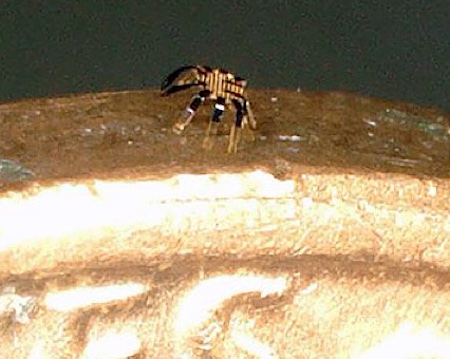Science Fiction
Dictionary
A B C D E F G H I J K L M N O P Q R S T U V W X Y Z
Smallest Remote-Controlled Walking Robot Crabs

Northwestern University engineers have invented the world’s smallest remote-controlled walking robot, just a half millimeter wide. Could any science fiction writer, however imaginative, conceive of a walking robot no bigger than a grain of sand?

(Remote-controlled walking robot crab)
It took a year and a half to create the miniscule metal creatures, said coauthor John A. Rogers, the Louis Simpson and Kimberly Querrey Professor of Materials Science and Engineering at Northwestern University.His team was comprised of students across varying academic levels who combined critical- and creative-thinking skills to design robots that looked like crabs as well as other animals like inchworms and crickets, he said.
Some students found the sideways motion of crabs to be amusing, which was the inspiration behind the crab robot, Rogers said. The tiny robot can also twist, turn and jump, he added.
The robots, which are made of a malleable shape-memory alloy, start out as flat objects, similar to a piece of paper. The legs and arms are bent so the robot can stand, he said. The crab stays standing on its legs until heat is used to get the crab to move, Rogers said.
A metallic object made of shape-memory alloy can be deformed but returns to its original shape once heat is applied to it, he explained.
(Via ImpactLab)
Technovelgy readers recall the scarab robot imagined by Raymond Z. Gallun in 1936. But I'd like to point out the ultra-microrobot from Gallun's 1937 story A Menace in Miniature.

("A robot no bigger than a grain of sand?)
You might want to compare the walking crab robot with the smallest robot in 2007, arguably Pico, that could turn on a dime.
(Pico really can turn on a dime)
Scroll down for more stories in the same category. (Story submitted 6/11/2022)
Follow this kind of news @Technovelgy.| Email | RSS | Blog It | Stumble | del.icio.us | Digg | Reddit |
Would
you like to contribute a story tip?
It's easy:
Get the URL of the story, and the related sf author, and add
it here.
Comment/Join discussion ( 0 )
Related News Stories - (" Robotics ")
Artificial Skin For Robots Is Coming Right Along
'... an elastic, tinted material that had all the feel and appearance of human flesh and epidermis.' - Harl Vincent (1934)
Robot Guard Dog On Duty
I might also be thinking of K-9 from Doctor Who.
Wearable Artificial Fabric Muscles
'It is remarkable that the long leverages of their machines are in most cases actuated by a sort of sham musculature...' HG Wells, 1898.
Dancing Robots Taught Dance Moves
'A clockwork figure would be the thing for you...' Jerome K. Jerome, 1893.
Technovelgy (that's tech-novel-gee!) is devoted to the creative science inventions and ideas of sf authors. Look for the Invention Category that interests you, the Glossary, the Invention Timeline, or see what's New.
Science Fiction
Timeline
1600-1899
1900-1939
1940's 1950's
1960's 1970's
1980's 1990's
2000's 2010's
Current News
The Zapata Air Scooter Would Be Great In A Science Fiction Story
'Betty's slapdash style.'
Thermostabilized Wet Meat Product (NASA Prototype)
There are no orbiting Michelin stars. Yet.
Could Crystal Batteries Generate Power For Centuries?
'Power could be compressed thus into an inch-square cube of what looked like blue-white ice'
India Ponders Always-On Smartphone Location Tracking
'It is necessary... for your own protection.'
Amazon Will Send You Heinlein's Knockdown Cabin
'It's so light that you can set it up in five minutes by yourself...'
Is It Time To Forbid Human Driving?
'Heavy penalties... were to be applied to any one found driving manually-controlled machines.'
Replace The Smartphone With A Connected Edge Node For AI Inference
'Buy a Little Dingbat... electropen, wrist watch, pocketphone, pocket radio, billfold ... all in one.'
Artificial Skin For Robots Is Coming Right Along
'... an elastic, tinted material that had all the feel and appearance of human flesh and epidermis.'
Robot Guard Dog On Duty
I might also be thinking of K-9 from Doctor Who.
Wearable Artificial Fabric Muscles
'It is remarkable that the long leverages of their machines are in most cases actuated by a sort of sham musculature...'
BrainBridge Concept Transplant Of Human Head Proposed
'Briquet’s head seemed to think that to find and attach a new body to her head was as easy as to fit and sew a new dress.'
Google's Nano Banana Pro Presents Handwritten Math Solutions
'...copy was turned out in a charming and entirely feminine handwriting.'
Edible Meat-Like Fungus Like Barbara Hambly's Slunch?
'It was almost unheard of for slunch to spread that fast...'
Sunday Robotics 'Memo' Bot Has Unique Training Glove
'He then started hand movements of definite pattern...'
Woman Marries Computer, Vonnegut's Dream Comes True
'Men are made of protoplasm... Lasts forever.'
Natural Gait With Prosthetic Connected To Nervous System
'The leg was to function, in a way, as a servo-mechanism operated by Larry’s brain...'
